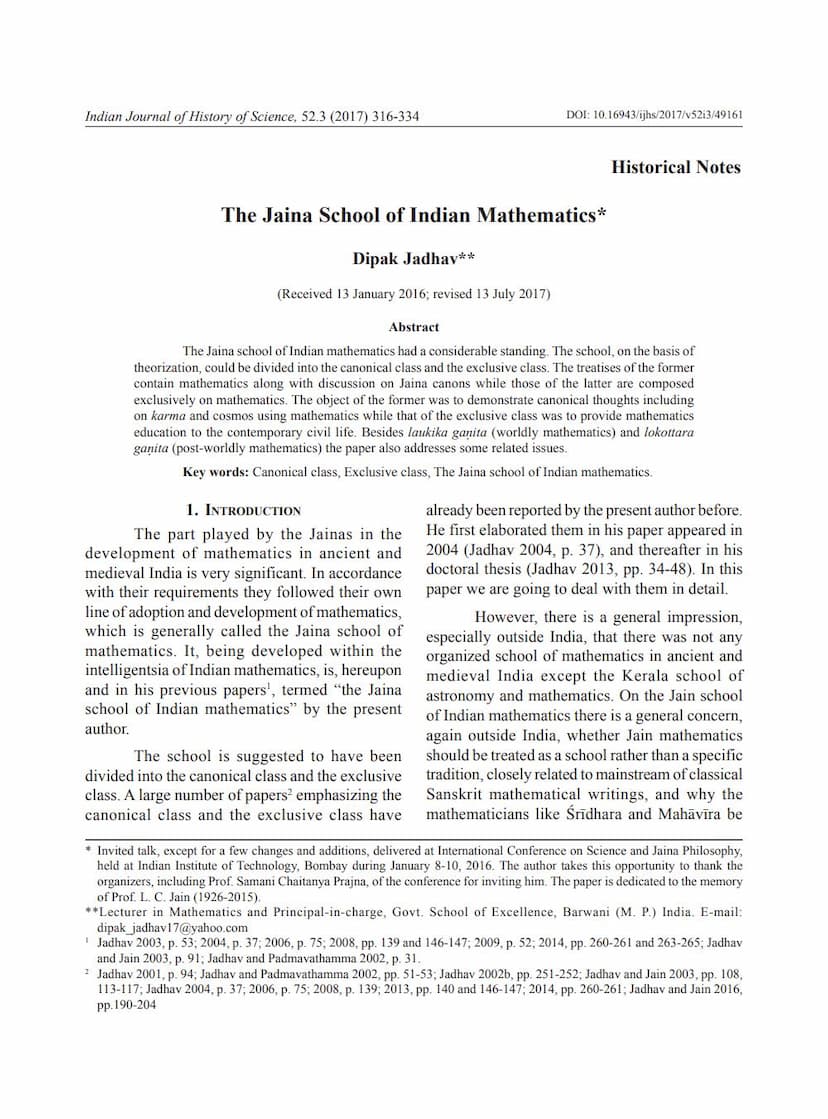Jaina School Of Indian Mathematics
Added to library: September 2, 2025

Summary
Here's a comprehensive summary of the provided text, "The Jaina School of Indian Mathematics" by Dipak Jadhav, focusing on its key arguments and classifications:
Core Argument: The paper argues for the recognition of a distinct "Jaina school of Indian mathematics" that developed and practiced mathematical thought for over two thousand years in ancient and medieval India. This school is characterized by its unique approaches and was not merely a subset of mainstream Sanskrit mathematical traditions.
Key Division of the Jaina School: Jadhav proposes and elaborates on a fundamental division of the Jaina school of mathematics into two classes:
-
Canonical Class:
- Content: Treatises in this class contain mathematics embedded within discussions of Jaina canons, philosophy, cosmology, or karma theory. The mathematics serves to explain or demonstrate these canonical concepts.
- Purpose: To illustrate Jaina philosophical and cosmological ideas using mathematical principles.
- Authors: These authors were primarily philosophers, cosmologists, or scholars of Jaina doctrine, who incorporated significant mathematical knowledge into their works. Examples include anonymous authors of early canonical texts like the Sūrya Prajñapti, Jambūdvipaprajñapti, and Bhagavati Sūtra, as well as later figures like Puspadanta and Bhūtabali (authors of Satkhaṇḍāgama) and Jinabhadra Gaṇī.
- Language: Primarily Prakrit, reflecting the early development and canonical nature of these texts.
-
Exclusive Class:
- Content: Treatises in this class are composed exclusively of mathematical content. They focus purely on mathematical concepts and methods.
- Purpose: To provide mathematics education for contemporary civil life, catering to the needs of common people and business activities.
- Authors: These were mathematicians who focused on developing and disseminating mathematical knowledge. Prominent figures include Śrīdhara (credited with Pātīganita and Trisatikā), Mahāvīra (author of Ganita-sāra-sangraha), Rājāditya (Vyavahāra-ganita), and Thakkara Pherū (Ganita-sāra-kaumudi).
- Language: Primarily Sanskrit, though some works were also in Apabhramsa or other regional languages.
Justification for the Division: Jadhav justifies this division based on the nature of the treatises and the intent of their authors. The canonical class uses mathematics to support religious or philosophical discourse, while the exclusive class uses mathematics for practical, worldly applications.
Distinction from Laukika and Lokottara Ganita: The paper also discusses the concepts of laukika ganita (worldly mathematics) and lokottara ganita (post-worldly or transcendental mathematics). Jadhav clarifies that these terms refer to the application of mathematics, not the classification of the school itself.
- Laukika ganita applies to mathematics used in everyday life.
- Lokottara ganita refers to mathematics used for more abstract or philosophical purposes, often dealing with concepts like infinity or complex cosmological calculations.
Jadhav notes that while lokottara ganita is prominently found in the canonical class (e.g., the complex number systems for karma theory), the exclusive class primarily focuses on laukika ganita. However, the distinction is not always clear-cut, as mathematical concepts can be applied in both worldly and transcendental contexts.
Addressing Misconceptions and Historical Context:
- Existence of a "School": Jadhav addresses the skepticism, particularly outside India, about whether a distinct "Jaina school" existed or if Jaina mathematicians were simply part of the broader Sanskrit tradition. He argues that their shared mathematical thoughts and distinct approaches, even across different sects (Svetāmbara and Digambara), justify the concept of a "Jaina school."
- Historical Recognition: The paper highlights earlier contributions by historians like B. B. Datta and L. C. Jain in identifying and studying the Jaina school. It also acknowledges the challenges in studying this field due to language barriers, specialized terminology, and the inaccessibility of many texts.
- Antiquity: The Jaina school's origins are traced back to early Jaina figures like Lord Rsabha and Lord Mahāvīra, suggesting a long and continuous development that paralleled developments in other ancient civilizations like Greece.
- Originality and Significance: Jadhav emphasizes the original mathematical contributions of the Jaina school, particularly in the canonical class, citing examples like the early work on infinity, logarithms, and sophisticated number systems used for cosmological and karma theories. These achievements, he argues, distinguish the Jaina school from others.
Relationship Between the Classes: The exclusive class is seen as emerging from and indebted to the canonical class, with mathematicians from the exclusive class often acknowledging their reliance on the works of the canonical scholars. This suggests an "upper" status for the canonical class within the Jaina school, as it represents the foundational philosophical and mathematical thought.
Conclusion: Jadhav concludes that the Jaina school of Indian mathematics is a legitimate and significant area of study. He reiterates that the division into canonical and exclusive classes is a useful theoretical framework for understanding its diverse contributions. He urges scholars not to solely focus on the practical works of the exclusive class, as the true depth and originality of the Jaina school lie in the canonical class, which integrated mathematics with profound philosophical and cosmological insights.